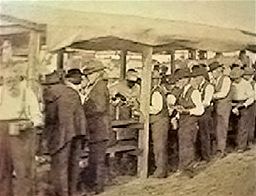9-15 July 1913
Battle of Gettysburg 50th Anniversary
A form of canned boneless meat — a staple of U.S. Army field rations since World War I — was first introduced at the fiftieth anniversary of the Battle of Gettysburg. The Army fed over 65,000 veterans of the Civil War who assembled on that hallowed ground in early July 1913.
 In order to handle the group, which far exceeded the original attendance estimates, an entirely new system of supply had to be improvised. During the encampment, selected cuts of fresh beef were chilled and boned in packing houses, and then packed in lined wooden shipping boxes.
In order to handle the group, which far exceeded the original attendance estimates, an entirely new system of supply had to be improvised. During the encampment, selected cuts of fresh beef were chilled and boned in packing houses, and then packed in lined wooden shipping boxes.
These cases of chilled and frozen meat were shipped by rail to Gettysburg, where they were distributed to the various messes.
Upon being received the meat was sliced into steaks for frying and broiling.
The importance of the Gettysburg experience went more or less unrecognized until shipping shortages in World War I forced Army subsistence personnel to look for new ways to try to conserve space onboard cargo ships going to Europe.
In 1918, Lieutenant Jay C. Hormel, QMC — later President of George A. Hormel and Company, of Austin, Minnesota — was sent from France back to the U.S. to develop a large-scale system of boneless beef production and supply. The next war would go a step further … with the advent of Spam.
Compiled by Dr. Steven Anders, former Quartermaster School historian.
Quote of the Week:
Give them great meals of beef and iron and steel, they will eat like wolves and fight like devils.— William Shakespeare, Henry V
